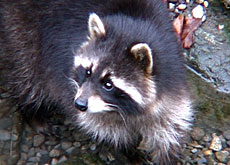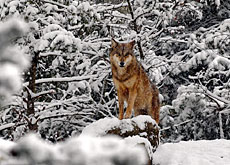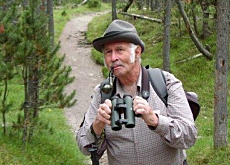Furry invasion threat to local wildlife

Indigenous animals are under threat from hordes of furry creatures making their way towards the Swiss border.
The raccoons, raccoon dogs and grey squirrels munching their way across Europe could destroy local species sharing similar environments. Many of the foreign species carry diseases to which Swiss animals have no immunity.
The Swiss environment agency believes the American grey squirrel poses the biggest threat.
The introduction of the species in Britain caused the near extinction of the native red squirrel.
The agency’s hunting expert, Christoph Jäggi, says it is just a question of time before the grey variety crosses over from the Italian Alps.
In Italy, the invasion started with just two pairs introduced to an ambassador’s garden in Turin in 1948.
Later efforts to destroy the expanding population were halted by animal welfare activists, and now there is no way of controlling the relentless northward migration of the Italian colony.
Grey vs red
According to the World Conservation Union (IUCN), grey squirrels are better at exploiting food in the forest than the red squirrel, and carry a virus that is lethal to the red squirrel.
The species causes irreparable damage to coniferous and broadleaved trees such as beech, oak, sycamore and Norway spruce.
Grey squirrels raid birds’ nests to prey on eggs and fledglings, and deprive native wildlife of food both in the wild and in gardens.
They also bother humans by gnawing through electricity cables.
“Grey squirrels pose such a threat to our native species that we would have to shoot them”, Jäggi told swissinfo. “We want the public to be prepared for this.”
Raccoons and raccoon dogs are also Swiss-bound.
Reich’s fauna
The two species look very similar, although raccoons are related to the bear, and raccoon dogs are canines. Raccoons are more portly, with slightly different facial markings.
Raccoons are indigenous to North America, but were released by the Nazi Party’s Hermann Goering in Kassel, Germany, in 1934 to “enrich the Reich’s fauna”.
Scientists say the animals are spreading to neighbouring countries at an alarming rate.
Until the beginning of the last century, the raccoon dog lived mostly in eastern Asia.
The Russians began to breed them for their thick fur, but soon discovered that the animals only grew the coveted winter coats in the wild.
So between 1928 and 1950 about 10,000 raccoon dogs were set free by Ukrainian breeders, and began to make their way slowly westwards.
Poland has the largest population.
Bird threat
Both of these species are a serious threat to birds, although raccoons wreak more havoc because they can climb trees.
Ground-nesting birds such as lapwings, field larks, whinchats and curlews are already endangered by farming practices.
“If raccoon and raccoon dog populations begin to multiply in Switzerland, these bird species could be completely wiped out,” Hans Schmid of Birdlife Switzerland told swissinfo.
The other threat to nature could come from the spread of rabies.
Red foxes and raccoon dogs are the only terrestrial rabies vectors in western Europe. This means that if they catch the disease, it gets passed on through the colony.
Bin raiders
Raccoons have become a health hazard in many German cities, where they rummage through garbage bins and invade homeowners’ attics and cellars. Now they are becoming a threat to agriculture.
In October 2005 vineyard owners across Germany hired bounty hunters to kill the animals and stop them from munching their way through the wine harvest.
Conceivably, Switzerland has all this to come.
There is no limit on hunting non-indigenous species but it would be a tall order to expect the country’s hunters to deal with the problem alone.
swissinfo, Julie Hunt
Switzerland only has a handful of raccoon dogs.
Germany has culled 20,000 raccoon dogs so far.
It is estimated that Germany has more than a million raccoons.
Switzerland is thought to have between 50 and 100.

In compliance with the JTI standards
More: SWI swissinfo.ch certified by the Journalism Trust Initiative



You can find an overview of ongoing debates with our journalists here . Please join us!
If you want to start a conversation about a topic raised in this article or want to report factual errors, email us at english@swissinfo.ch.